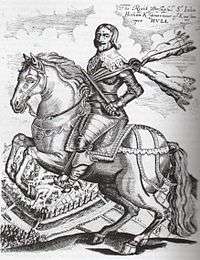Sir John Hotham, 1st Baronet


Sir John Hotham, 1st Baronet, of Scorborough (circa July 1589 – 3 January 1645), English parliamentarian, who was governor of Hull in 1642 shortly before the start of the English Civil War. He refused to allow Charles I of England or any member of his entourage to enter the town, thereby depriving the King access to the large arsenal contained within. Later in the Civil war he and his son, John Hotham the younger, were accused of treachery, found guilty and executed.
Biography
Hotham, born probably in July 1589[1] belonged to a Yorkshire family. His father was John Hotham (1540-1609), MP for Scarborough, where the family lived, in 1584. His mother has been variously given as Julian, the daughter of Sir Michael Stanhope of Shelford, Nottinghamshire[2] or as Jane, daughter of Richard Legard of Rysome, Yorkshire.[1]
Sir John Hotham fought on the continent of Europe during the early part of the Thirty Years' War.[2]
In 1622 he was made a baronet. He was Member of Parliament for Beverley in the five parliaments between 1625 and 1640, and High Sheriff of Yorkshire in 1634. In 1639 he was deprived by the king of his office of governor of Hull, and joining the parliamentary party, he refused to pay ship-money. In January 1642 Hotham was ordered by the parliament to seize Hull, where there was a large store of munitions of war; this was at once carried out by his son (John Hotham the younger). Hotham senior took command of Hull and in April 1642 refused to admit Charles I to the town. Later he promised his prisoner, Lord Digby, that he would surrender the town to the king, but when Charles appeared again he refused a second time and drove away the besiegers.[2]
Meanwhile, the younger Hotham was taking an active part in the Civil War in Yorkshire and Lincolnshire, but was soon at variance with other parliamentary leaders, especially with Lord Fairfax and his son Sir Thomas Fairfax, and complaints about his conduct and that of his troops were made by Oliver Cromwell and by Colonel John Hutchinson. Soon both the Hothams were corresponding with the Earl of Newcastle, and the younger one was probably ready to betray Hull; these proceedings became known to Parliament, and in June 1643 father and son were captured and taken to London.[2]
After a long delay they were tried by court-martial, were found guilty and were sentenced to death. The younger Hotham was beheaded on 2 January 1645, and in spite of efforts made by the House of Lords and the Presbyterians to save him, the elder suffered the same fate on the following day. Father and son were buried at the nearby church of All Hallows Barking[1] although a tomb monument (illustrated here) was also erected at St Mary's Church, South Dalton.
Family
The younger John Hotham's mother was Katherine Rhodes, daughter of Sir John Rhodes, whom the father married 16 February 1606/1607. Sir John Hotham had two other sons who were persons of some note, by his second wife, Anne Rokeby, daughter of Ralph Rokeby, (married 16 July 1614):
- Charles Hotham (1615 – c. 1672), rector of Wigan, a Cambridge scholar and author of Ad philosophiam Teutonicam Manuductio (1648)
- Durant Hotham (1617–1691), who wrote a Life of Jakob Boehme (1654).
See also
Notes
References
- Attribution
-
 This article incorporates text from a publication now in the public domain: Chisholm, Hugh, ed. (1911). "Hotham, Sir John". Encyclopædia Britannica. 13 (11th ed.). Cambridge University Press. p. 803.
This article incorporates text from a publication now in the public domain: Chisholm, Hugh, ed. (1911). "Hotham, Sir John". Encyclopædia Britannica. 13 (11th ed.). Cambridge University Press. p. 803.
Further reading
| Wikimedia Commons has media related to Sir John Hotham, 1st Baronet. |
| Wikisource has the text of the 1885–1900 Dictionary of National Biography's article about Hotham, John Sr. (d.1645). |
- Lundy, Darryl (5 August 2012), Sir John Hotham, 1st Bt, p. 22438 §224375